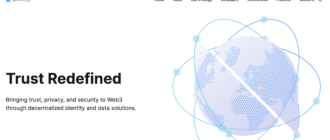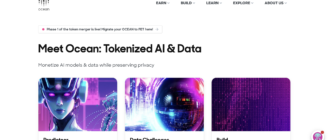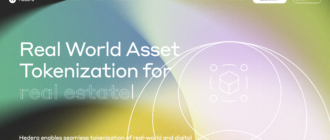This article delves into the Velas blockchain project and its native cryptocurrency, VLX. We will explore the core components of Velas, including its technological infrastructure, tokenomics, and the ecosystem it supports. By examining these elements, we aim to provide a comprehensive understanding of Velas, its unique features, and its position within the broader blockchain and cryptocurrency landscape. Additionally, we will discuss the growth prospects and future development plans for the Velas project, offering insights into its potential trajectory in the rapidly evolving crypto space.

What is Velas?
Velas, an acronym for Virtual Expanding Learning Autonomous System, is a high-performance blockchain network designed to address scalability, security, and interoperability issues inherent in traditional blockchain systems. Utilizing a unique blend of Delegated Proof of Stake (DPoS) and Artificial Intelligence (AI) powered consensus mechanism, Velas aims to provide a scalable solution that can handle a large number of transactions per second (TPS) without compromising decentralization. This hybrid consensus mechanism leverages AI to optimize block creation and validation, ensuring efficient and secure transaction processing. The Velas blockchain supports a wide range of decentralized applications (dApps), fostering an ecosystem that enhances user experience and developer engagement through its innovative technology stack.
Project History
Founded in 2019, Velas has undergone significant development and evolution since its inception. The project was established to create a scalable and secure blockchain platform capable of supporting a diverse array of decentralized applications. Key milestones in Velas’ development include:
- 2019: Launch of the Velas blockchain, introducing its hybrid AI-enhanced DPoS consensus mechanism.
- 2020: Release of the Velas Wallet, providing users with a secure and user-friendly interface for managing VLX tokens and interacting with the Velas blockchain.
- 2021: Integration of the Velas blockchain with various decentralized finance (DeFi) platforms, expanding its ecosystem and enhancing its utility in the DeFi space.
- 2022: Major network upgrade to improve scalability and performance, allowing Velas to support a higher throughput of transactions and more complex smart contracts.
- 2023: Expansion of the Velas ecosystem through strategic partnerships and the launch of new projects, further solidifying its position in the blockchain industry.
Throughout its history, Velas has consistently focused on innovation and community engagement, driving its growth and adoption within the blockchain sector.
How Velas Works
Velas operates on a sophisticated technology stack that combines blockchain innovation with artificial intelligence (AI) to deliver high performance, security, and scalability. Central to Velas’ architecture is its hybrid consensus mechanism, which integrates Delegated Proof of Stake (DPoS) with AI-enhanced optimization. This unique combination ensures efficient block validation, reduces energy consumption, and maintains a high level of decentralization.
Blockchain and Consensus Mechanism
The Velas blockchain is built to handle a large volume of transactions per second (TPS), making it one of the fastest blockchain networks available. This is achieved through the use of DPoS, where network participants vote for a limited number of delegates who are responsible for validating transactions and creating new blocks. The inclusion of AI in this process further optimizes the selection of validators and the overall network performance.
Delegated Proof of Stake (DPoS)
In the DPoS mechanism, token holders use their stake to vote for a set of trusted delegates. These delegates, also known as validators, are tasked with maintaining the blockchain’s integrity by validating transactions and producing new blocks. This method significantly enhances transaction throughput and reduces the time needed to reach consensus compared to traditional Proof of Work (PoW) systems.
AI-Powered Optimization
Velas distinguishes itself from other blockchain platforms through the integration of AI within its consensus algorithm. The AI component monitors and adjusts the parameters of the blockchain in real-time, optimizing the performance of the validators and ensuring that the network remains resilient under varying loads. This AI-driven approach not only improves efficiency but also enhances security by predicting and mitigating potential threats.
Technical Details
- Transaction Speed: Velas can process up to 30,000 transactions per second, a capability driven by its efficient consensus mechanism and advanced network architecture.
- Scalability: The blockchain’s design allows it to scale seamlessly as the network grows, supporting an increasing number of dApps and transactions without compromising performance.
- Security: The integration of AI provides an additional layer of security by constantly monitoring the network for anomalies and optimizing validator selection to prevent malicious activities.
- Interoperability: Velas supports cross-chain interactions, enabling seamless integration with other blockchain networks and expanding its utility across various platforms.
By leveraging these advanced technologies, Velas offers a robust, scalable, and secure platform for decentralized applications, setting it apart from other blockchain projects and positioning it as a leading contender in the cryptocurrency space.
Tokenomics of Velas (VLX)
VLX is the native cryptocurrency of the Velas blockchain, functioning primarily as a token rather than a standalone coin. This distinction is important as VLX is integral to the operation and governance of the Velas network, supporting various functionalities within the ecosystem.
Tokenomics Overview
The tokenomics of VLX are designed to incentivize participation, ensure network security, and support the ecosystem’s growth. Key aspects of VLX tokenomics include its emission model, distribution, and current market dynamics.
Emission Model
The emission of VLX follows a predefined schedule, ensuring a steady and controlled supply of tokens over time. This model is crucial for maintaining the token’s value and supporting the network’s long-term sustainability. The total supply of VLX is capped, which means that there is a finite number of tokens that will ever be in circulation.
- Initial Supply: At the launch of the Velas blockchain, a certain amount of VLX was pre-mined to bootstrap the network and provide initial liquidity.
- Ongoing Emission: New VLX tokens are generated as rewards for validators participating in the DPoS consensus mechanism. This incentivizes validators to maintain the network’s security and integrity.
Distribution
The distribution of VLX tokens is designed to balance the interests of various stakeholders, including the development team, validators, and the broader community. The distribution strategy ensures that no single entity has excessive control over the network, promoting decentralization and community involvement.
| Category | Percentage of Total Supply |
|---|---|
| Founders and Team | 20% |
| Validators | 30% |
| Community Rewards | 25% |
| Reserve Fund | 15% |
| Partnerships | 10% |
Market Dynamics
VLX’s market value is subject to fluctuations based on supply and demand dynamics, market sentiment, and the overall performance of the Velas ecosystem. The token is traded on several major cryptocurrency exchanges, providing liquidity and accessibility for investors and users.
- Current Price: The price of VLX can vary significantly over time. As of the latest data, VLX is traded at approximately $0.10 per token.
- Market Capitalization: VLX has a market capitalization that reflects its adoption and utilization within the Velas ecosystem. This metric is a key indicator of the project’s growth and market presence.
Use Cases
VLX tokens serve multiple purposes within the Velas network, including:
- Transaction Fees: Users pay transaction fees in VLX for transferring tokens and interacting with dApps on the Velas blockchain.
- Staking: Holders of VLX can stake their tokens to support network security and earn rewards in return.
- Governance: VLX token holders participate in the governance of the Velas network, voting on key proposals and decisions that shape the future of the project.
By understanding the tokenomics of VLX, stakeholders can better appreciate the economic model that underpins the Velas network and its potential for future growth.
Where to Buy VLX
VLX, the native token of the Velas blockchain, is available for trading on several major cryptocurrency exchanges. Here are the primary platforms where you can purchase VLX:
- HTX (formerly Huobi): A well-established exchange known for its security and diverse range of supported cryptocurrencies, including VLX.
- Gate.io: A rapidly growing exchange providing access to various digital assets and strong trading support for VLX.
- BingX: Known for its robust trading infrastructure and user-friendly interface, BingX offers trading pairs for VLX.
- KuCoin: A popular exchange that supports a broad selection of cryptocurrencies, including VLX, and offers competitive trading fees.
These exchanges provide various trading pairs, typically including VLX/USD, VLX/USDT, and VLX/BTC, allowing users to buy VLX with different fiat currencies or cryptocurrencies.
Where to Store VLX
Storing your VLX tokens securely is crucial to protecting your investment. Here are some of the best options for storing VLX:
- Velas Wallet: The official wallet provided by the Velas network, offering a secure and user-friendly way to store and manage VLX tokens. It supports staking, enabling users to earn rewards by participating in the network’s consensus process.
- Trust Wallet: A widely used mobile wallet that supports VLX and provides a high level of security and convenience. It allows users to store, send, and receive VLX easily.
- Ledger Nano S/X: Hardware wallets are considered one of the most secure methods for storing cryptocurrencies. Both Ledger models support VLX and offer offline storage to protect your tokens from online threats.
- Atomic Wallet: A desktop and mobile wallet that supports a variety of cryptocurrencies, including VLX. It offers features such as staking and built-in exchange services.
- Exodus Wallet: A user-friendly desktop and mobile wallet that supports VLX and provides an integrated exchange feature for trading within the wallet.
When choosing a wallet, consider factors such as security features, ease of use, and additional functionalities like staking and integrated exchange services. Using a combination of hardware and software wallets can provide an extra layer of security for your VLX tokens.
Project Prospects
Basis for Growth
The growth of the Velas project is underpinned by its innovative technology and strategic positioning within the blockchain space. Velas’ unique combination of AI-enhanced Delegated Proof of Stake (DPoS) and high transaction throughput makes it a compelling choice for developers and enterprises seeking scalable and efficient blockchain solutions. This technological edge is a primary driver of its adoption and expansion.
Clients and Partners
Velas has established partnerships with several key players in the blockchain and technology sectors, which enhances its credibility and expands its reach. Some notable partners and clients include:
- CoinPayments: Integration with CoinPayments provides Velas users with the ability to conduct transactions with numerous merchants worldwide.
- BlueZilla: Collaboration with BlueZilla helps in launching and marketing blockchain projects within the Velas ecosystem.
- Solana: Strategic partnership with Solana to enhance cross-chain compatibility and interoperability.
- WagyuSwap: A decentralized exchange built on the Velas blockchain, offering trading and liquidity services to the Velas community.
These partnerships not only boost Velas’ technological capabilities but also expand its user base and application potential.
Future Development Forecast
The future development of Velas looks promising, with several initiatives and upgrades planned to further enhance its capabilities and ecosystem. Key areas of focus include:
- Scalability Enhancements: Continued improvements to the network’s scalability to handle even larger volumes of transactions as adoption grows.
- Ecosystem Expansion: Encouraging more developers to build dApps on the Velas blockchain, supported by grants and developer programs.
- DeFi Integration: Expanding Velas’ presence in the decentralized finance (DeFi) space through partnerships and the development of native DeFi applications.
- AI Integration: Further integrating AI to optimize network performance and enhance security measures.
These strategic initiatives are expected to drive Velas’ growth and solidify its position as a leading blockchain platform.
Ecosystem
The Velas ecosystem is a dynamic and growing network of decentralized applications (dApps), services, and partners that leverage Velas’ robust blockchain infrastructure. Key components of the Velas ecosystem include:
- WagyuSwap: A decentralized exchange that offers seamless trading and liquidity solutions within the Velas network.
- Velas Wallet: An official wallet that provides secure storage and staking options for VLX tokens, enhancing user engagement.
- VelasPad: A launchpad for new blockchain projects and tokens within the Velas ecosystem, providing support for fundraising and marketing.
- Velas Grant Program: An initiative to support developers and startups building on Velas, offering funding and resources to promote innovation.
Key Ecosystem Projects
- WagyuSwap: Facilitates decentralized trading and liquidity provision, essential for the DeFi segment of the Velas ecosystem.
- Velas Wallet: Ensures secure and efficient management of VLX tokens, integral for user participation and staking.
- VelasPad: Accelerates the development and launch of new blockchain projects on the Velas platform.
These components and projects highlight the vibrant and expanding nature of the Velas ecosystem, providing a solid foundation for future growth and innovation.
Conclusion
In summary, Velas represents a significant innovation in the blockchain sector, combining advanced technology with a robust ecosystem. Its approach to addressing common blockchain challenges sets it apart as a noteworthy project. As we look forward, Velas’ strategic developments and community engagement will be crucial in shaping its future success and influence in the cryptocurrency world.






